Text




No illusions
For Midsummer Night, from Stella di Lemmen
This is the time for shame.
A time when, as a human being, I feel a deep shame for belonging to this humanity. Or rather, to this inhumanity.
We are going through yet another tragic moment in history, in which we—and no one should exclude themselves, not even those who believe silence will protect them—are, in order to defend our privileges, imposing our power by annihilating another part of humanity.
We impose our supremacy, our belief system that we claim to be “the only right one,” our so-called “right” to life through the death of others.
We do this on a tiny speck of a planet spinning through a boundless cosmos. Once again, we prove how far we are from embracing the idea of an Earth that truly hosts all its inhabitants, offering shelter and food without discrimination. And yet we call ourselves evolved.
But this time, thanks to evolution and, admittedly, to the usefulness of technology, we are all at risk. “The righteous” and “the unrighteous” alike.
And I cannot help but say it: it is exactly what we deserve.
Jiddu Krishnamurti, for those who don’t know him, once said:
“Do not mourn the murdered. Mourn the murderer.”
What a powerful truth, if we truly understand what it means to Be.
From war to flowers, from Alpha to Omega, Being is the center of existence.
Whether we suffer from a delusion of omnipotence or from the loss of life—someone else’s, because when we die, we are no longer here—or from the loss of an eye, a leg, or an entire family, it is Being that underlies it all. And Being is one.
What a pity not to understand this. That is the true price of freedom.
Many have tried to explain it to us. Never have their efforts felt more in vain than now.
At this moment, Stella di Lemmen drifts in the heat and magnificence of summer. It is overflowing with flowers of every shape and color, sublime and silent messengers of life and beauty.
We will gather some of them this evening, on Midsummer Night, and place them in water, so that tomorrow morning we can wash our faces with it.
Our faces, not our consciences.
Let us not deceive ourselves. Shame is essential. It is a fundamental condition for real change.
After all, it was said more than two thousand years ago, and perhaps it is worth remembering:
“Peace on Earth to people of goodwill.”
Wishing you all a true Midsummer, without illusions, from Stella di Lemmen.
Senza inganni
Per la notte di San Giovanni, da Stella di Lemmen
È il momento della vergogna.
È il momento nel quale in quanto umano mi vergogno profondamente di far parte di questa umanità, o meglio di questa disumanità.
Stiamo attraversando un ennesimo, tragico, momento storico, dove noi, e che nessuno si chiami fuori, compresi gli illusi che pensano di cavarsela col silenzio, per difendere i nostri privilegi, imponiamo il nostro potere annientando un’altra parte di umanità. Imponiamo la nostra supremazia, il nostro credo, che è “l’unico giusto”, il nostro “diritto” alla vita attraverso l’altrui morte.
Lo facciamo su uno sputo di pianeta che viaggia in un cosmo immenso, senza confini, dimostrando ancora una volta che l’idea di una Terra che ospita tutti quanti i suoi abitanti e offre loro indiscriminatamente un riparo e del cibo è ancora lontana, e ci chiamiamo evoluti.
Però questa volta, grazie all’evoluzione, alla, per carità, utilissima tecnologia, rischiamo la ghirba tutti quanti, “giusti” e “non giusti”. Non posso non dire che è quanto ci meritiamo.
Jiddu Krishnamurti, peccato per chi non lo conosce, diceva: “Non piangete per l’ucciso, piangete per l’uccisore.” Quale grande verità, se capiamo che cosa vuol dire Essere.
Dalla guerra ai fiori, dall’Alfa all’Omega, l’Essere è il fulcro dell’esistenza. Che soffriamo di delirio di onnipotenza o della perdita della vita (altrui perché quando moriamo noi non ci siamo più), o di un occhio, o di una gamba, o della famiglia intera è l’Essere che sottintende a tutto quanto, e l’Essere è uno.
Peccato non capirlo. È questo il prezzo della libertà.
In molti hanno cercato di spiegarcelo, mai come ora vani i loro sforzi.
In questo momento Stella di Lemmen fluttua nella calura e nella magnificenza estiva, è stracolma di fiori, di tutte le fogge, di tutti i colori, messaggeri sublimi e silenziosi di vita e di bellezza.
Ne raccoglieremo alcuni e stasera, la notte di San Giovanni, li metteremo a bagno nell’acqua per lavarci il viso domani mattina. Il viso, non la coscienza. Cerchiamo di non ingannarci, la vergogna è essenziale, fondamentale principio per il cambiamento.
D’altra parte pare ci sia stato detto più di duemila anni fa e forse vale la pena ricordarlo: “Pace in terra agli uomini di buona volontà.”
Buon San Giovanni a tutti, senza inganni, da Stella di Lemmen.



0 notes
Text


The joy of the vineyard
Do you see those tiny leaves, just unfurled, sprouting in clusters from the buds of the fruiting canes? Wrinkled and delicately tinted with yellow and pink, just enough to announce that they’ll soon turn green!!
I could watch them forever, all the same and yet each one different!
This is how the new season begins here in the vineyard at Stella di Lemmen — between rain and mist, wind and sudden bursts of sunshine — in this stormy, shadowy spring, with the sea down below looking like a sheet of steel.
Another “annus horribilis” on the horizon? Who can say? “You can’t command time or the heart,” they say.
Still, it’s a joy and a celebration for the soul to witness such a promise.
One after the other, as far as the eye can see, each vine seems to recite its own little poem — the opening of the dance. And no, not a single one holds back in celebrating life. All of them swept up together by spring’s vitality.
Will we once again be able to support their needs with determination and respect this year? To interpret the season’s variables at our best? To help them defend themselves from challenging weather? So many dashes up and down the fields await — to mow the cover crops, to select the canes, to check… Will we be up to it this year??
Will we be able to protect this treasure with the utmost care, honoring the earth, the plant, ourselves, and those who will drink our wine?
We’ll try, we’ll try — don’t worry. This year we even have Lili with us, reinforcements from Switzerland… a great promise in the world of viticulture!
So, back to us: we’re happy to wish you all a Happy Easter.
May joy be your surprise gift! And you don’t need to go far to find it — it’s right here, within reach for everyone. It’s inside us.
If needed, come see the vineyard and its freshly opened leaves — they’ll remind you!
La gioia della vigna
Le vedete quelle foglioline appena dispiegate, che a mazzetti spuntano dalle gemme dei capi a frutto? Stropicciate e delicatamente tinte di giallo e rosa, giusto per annunciare che così presto saranno verdi!!
Non mi stancherei mai di guardarle, tutte uguali e una diversa dall’altra!
Così comincia la nuova stagione della vigna qui a Stella di Lemmen, tra pioggia e bruma, vento e squarci assolati, in questa primavera burrascosa e fosca, con il mare che, laggiù, pare una lastra d’acciaio.
Forse un altro anno “horribilis” alle porte? Chi può dirlo? “Al tempo e al cuor non si comanda”, dicono.
È comunque una gioia e una festa per l’anima affacciarsi su cotanta promessa.
Una dopo l’altra, a perdita d’occhio, ogni vite pare declamare una piccola, personale poesia: l’apertura delle danze. E no, nessuna di loro si risparmia nel celebrare la vita, tutte insieme travolte dal vigore primaverile.
Riusciremo anche quest’anno a sostenere con tenacia e rispetto le loro esigenze? A interpretare al meglio le variabili della stagione? Ad aiutarle nel difendersi dai possibili agenti atmosferici contrari? Quante corse annunciate su e giù per i campi, a tagliare il sovescio, selezionare i capi, controllare… Saremo all’altezza anche quest’anno??
Riusciremo a proteggere questo tesoro con il massimo riguardo, rispettando all’unisono la terra, la pianta, noi stessi e chi berrà il nostro vino?
Ci proviamo, ci proviamo, non preoccupatevi. Quest’anno abbiamo anche Lili con noi, rinforzi dalla Svizzera… una grande promessa della viticoltura!
Allora, tornando a noi, ci fa piacere augurare a tutti una Buona Pasqua.
Che la gioia sia la vostra sorpresa! E non c’è bisogno di andare lontano per trovarla: è qui, a portata di mano per tutti, è dentro di noi.
In caso, venite a vedere le vigne con le loro foglioline appena aperte: loro ve lo ricorderanno!


#biodynamicfarming#biologico#biodinamica#farming#cinqueterre#italianwine#biodynamicwine#wineyards#winery#wine
1 note
·
View note
Text

Addio a un’amica che muore.
Ciao Nico, è arrivato il momento del commiato. Questa volta tocca a me salutare te, che te ne sei andata in silenzio, con il sorriso e i tuoi begli occhi celesti, sempre portati con orgoglio, con il viso disteso, senza paura, senza pene o rancori.
L’ultima volta che ci siamo viste, prima che lasciassi il tuo letto d’ospedale, mi hai persino chiesto un bacio. Sapevi che sono sempre restia a concederne, come io so di averti salutato tante volte senza elargirne, lasciandoti un po’ perplessa per il mio modo poco espansivo di essere amica.
Forse è proprio questa la forza dell’amicizia: concedere all’altro di essere se stesso, anche quando non corrisponde esattamente alle nostre attese. Per nostra grazia, gli amici ci introducono alla tolleranza e alla magnanimità.
Non è da molto che ci conosciamo, nemmeno dieci anni. Ricordo ancora la prima volta che ci siamo incrociate: avevo percepito un certo distacco da parte tua. In fondo, non era affatto scontato che saremmo diventate amiche. Le amicizie nate in età adulta, poi, lo sono ancora meno. Ma al secondo incontro ci ha pensato Uga, la tua bella cagnolina, a mettere tutti d’accordo.
Ti ringrazio dal profondo del cuore per i momenti trascorsi insieme: le chiacchiere, le risate, i pranzi della domenica e le cene d’estate, la “bagna cauda” che “comelafacevitunonlafanessuno”, le passeggiate e i giri per raccogliere le uova, l’ascolto che mi hai sempre donato, i consigli che non ho seguito, lo yoga in barca, il tuo aiuto con le erbe officinali e le tue ricette di liquori. E grazie anche per i tuoi strofinacci “della nonna”, quelli di tela rigida, che mi saranno sempre cari.
Grazie, infine, per come te ne sei andata. Senza drammi, in punta di piedi, lasciando dietro il meglio di te. È una lezione che non dimenticherò e che cercherò di replicare.
Ho piantato delle iris sotto ai tuoi amati olivi. Fioriranno per te e per chi rimane, con o senza il tuo ricordo.
Riposa in pace, ti terrò nel cuore.
Tua, Lu.
Farewell to a Friend Who Has Passed
Ciao Nico, the time has come to say goodbye. This time, it is my turn to bid farewell to you, who left in silence, with a smile and your beautiful blue eyes—always carried with pride—and a serene face, without fear, without pain or resentment.
The last time we saw each other, before I left your hospital bed, you even asked me for a kiss. You knew I am always reluctant to give them, just as I know I often said goodbye without offering one, leaving you a little perplexed by my not-so-affectionate way of being a friend.
Perhaps that is the true strength of friendship: allowing the other to be themselves, even when they do not align exactly with our expectations. By grace, friends introduce us to tolerance and magnanimity.
We haven’t known each other for long, not even ten years. I still remember the first time we met—I sensed a certain distance from you. After all, there was no guarantee we would become friends. Friendships that begin in adulthood are even less predictable. But at our second meeting, Uga, your beautiful little dog, took care of bringing us together.
I thank you from the bottom of my heart for the moments we shared: the conversations, the laughter, the Sunday lunches and summer dinners, the bagna cauda that “nobody made like you did,” the walks and our egg-gathering rounds, the way you always listened to me, the advice I never followed, the yoga on the boat, your help with medicinal herbs and your liquor recipes. And thank you, too, for your “grandmother’s” dish towels, the stiff cotton ones—I will always cherish them.
And finally, thank you for the way you left. Without drama, quietly, leaving behind the best of you. That is a lesson I will never forget, and one I will try to emulate.
I planted irises beneath your beloved olive trees. They will bloom for you and for those who remain, with or without your memory.
Rest in peace, I will keep you in my heart.
Yours, Lu.





1 note
·
View note
Text

Il bello di una stalla
L’anno appena trascorso è stato impegnativo, segnato da molte sfide: un clima instabile, difficoltà impreviste e muri caduti. Non solo quelli di pietra, tipici delle Cinque Terre e messi a dura prova dalle intemperie, ma anche quelli interiori. Abbiamo visto incrinarsi certezze, abitudini consolidate e quei “baluardi” mentali a cui ci aggrappiamo nei momenti difficili.
Ora, nel cuore dell’inverno, volgendo lo sguardo indietro, è importante soffermarsi sugli eventi positivi che, nonostante tutto, non sono mancati.
Qui, a Stella di Lemmen, è stata la stalla a guadagnarsi il primo posto tra le cose belle accadute. La stalla e, naturalmente, i suoi abitanti.
Ricostruita sulle fondamenta di un antico rudere al margine del bosco e in parte scavata nella roccia, oggi la stalla è il rifugio perfetto per quattro asini romagnoli e un cavallino Falabella. Questa nuova “famiglia” si è felicemente integrata nella nostra azienda, portando con sé gioia e vitalità.
Tra loro, l’ultima arrivata è stata un dono speciale. Nata qui da noi tre mesi fa, il 10 ottobre, in un’alba così scura e nebbiosa da non distinguere un metro di sentiero, l’abbiamo chiamata Sole. Un nome che celebra la promessa di luce, anche nei giorni più cupi.
La stalla è diventata la mia prima meta del mattino. Ogni giorno, ancora al buio, salgo a trovare i miei amici dalle lunghe orecchie che, insieme al mini stallone, mi aspettano fedelmente all’ingresso del recinto, con qualsiasi tempo.
È un momento prezioso della mia giornata. Con la campagna ancora avvolta nel sonno, alla luce fioca della lampadina, entro nella quiete della stalla e mi immergo nel silenzio dell’inverno, un luogo dove ogni giorno si rinnova la promessa della vita.
Mentre ripulisco, gli animali mangiano il fieno che ho portato loro. Uno alla volta si avvicinano, curiosi, sperando di ricevere una carota, un pezzo di mela o un piccolo tronchetto d’avena. Lo sapevate? Gli asini sono incredibilmente golosi!
Poco a poco, la luce inizia a filtrare tra le sagome scure degli alberi, annunciando l’arrivo di un nuovo giorno.
Col cuore colmo di gratitudine, una volta terminati i miei compiti, saluto i miei compagni di stalla e scendo verso il mare. Un’altra giornata di lavoro mi attende, ma ogni volta, con la luce del mattino, si rinnova il miracolo: dal buio riappare il mondo.
The Beauty of a Stable
The past year has been challenging, marked by numerous difficulties: unpredictable weather, unforeseen obstacles, and fallen walls. Not only the stone walls typical of the Cinque Terre, worn down by storms, but also the inner walls within ourselves. Certainties cracked, long-standing habits were shaken, and those mental “fortresses” we cling to in hard times began to falter.
Now, in the heart of winter, looking back, it’s important to focus on the positive events that, despite everything, have not been lacking.
Here at Stella di Lemmen, the stable has taken first place among the good things that happened. The stable and, of course, its inhabitants.
Rebuilt on the foundations of an old ruin at the edge of the woods and partially carved into the rock, the stable is now the perfect shelter for four Romagnolo donkeys and a Falabella pony. This new “family” has happily integrated into our farm, bringing joy and vitality.
Among them, the most recent arrival has been a truly special gift. Born here three months ago, on October 10th, during a morning so dark and foggy you couldn’t see a meter ahead, we named her Sole (“Sun”). A name that celebrates the promise of light, even on the darkest days.
The stable has become my first destination every morning. Each day, while it’s still dark, I head up to visit my long-eared friends, who, along with the miniature stallion, faithfully wait for me at the enclosure gate, no matter the weather.
It’s a cherished moment in my day. With the countryside still asleep and under the faint glow of a lightbulb, I step into the quiet of the stable and immerse myself in the silence of winter—a place where the promise of life renews itself daily.
As I clean, the animals munch on the hay I’ve brought them. One by one, they approach me curiously, hoping for a carrot, a piece of apple, or a small oat stick. Did you know? Donkeys have a remarkable sweet tooth!
Slowly, light begins to seep through the dark shapes of the trees, announcing the arrival of a new day.
With my heart full of gratitude, once my tasks are complete, I say goodbye to my stable companions and make my way down towards the sea. Another workday awaits, but each time, as the morning light emerges, the miracle is renewed: the world reappears from the darkness.






0 notes
Text


July, Harvest Time
Our neighbor Luciano told us that wheat was once cultivated in Lemmen. He reported that the community square, where the small church now stands (originally a farmhouse ruin donated to the people of the village to make it their chapel), was once slightly concave precisely to allow for the threshing of wheat.
This supports the hypothesis that Lemmen was one of the primordial settlements in the area that later gave rise to the village of Riomaggiore. Some of its terraces, exceptionally wide compared to the average, allowed for the sowing of wheat for the community.
We wanted to conduct an experiment to commemorate ancient times and to add another small piece to the biodiversity and varied food production of Stella di Lemmen.
Wheat has always been the food of man. The collection of spontaneous species that constituted its origins - a natural hybridization between pseudocereals and grasses - began with Paleolithic man and stabilized in the Neolithic with the practice of agriculture. Today wheat is cultivated all over the world - it is the second most produced cereal after corn and hundreds of species are counted - but it was already placed in Egyptian tombs as "food to take to the afterlife", and described in the Gospel of John by Jesus as a symbol of resurrection, through the analogy of the grain that dies to give the ear, survival, eternal life.
We wanted to reintroduce the cultivation of wheat in our farm, as a symbol of rebirth linked to food, nutrition, and prosperity. We have sown an ancient Lucchese wheat that has grown healthy and strong. Now that we have harvested and threshed it, all that remains is to make bread. We hope it is a good omen of growth and transformation for all humanity.
Luglio, tempo di mietitura
È stato Luciano (Bonanni n.d.r.) a raccontarci che a Lemmen un tempo si coltivava il grano. Ci ha riferito che la piazzetta della comunità, dove si affaccia ora la piccola chiesa (in origine un rudere contadino donato alle genti del borgo perché ne facessero la loro cappella), un tempo era leggermente concava proprio per permettere la battitura del grano.
Questo avvalora l’ipotesi che Lemmen fosse uno degli insediamenti primordiali della zona che in seguito diedero origine al paese di Riomaggiore. Alcune delle sue fasce, eccezionalmente larghe rispetto alla media, consentivano di seminare il grano per la comunità.
Noi abbiamo voluto fare un esperimento che commemorasse i tempi antichi, per aggiungere un altro piccolo tassello alla biodiversità e alla variegata produzione alimentare di Stella di Lemmen.
Il grano è da sempre il cibo dell’uomo. La raccolta delle specie spontanee che costituirono le sue origini - una naturale ibridazione tra pseudocereali e graminacee - iniziò con l’uomo del Paleolitico e si stabilizzò nel Neolitico con la pratica dell’agricoltura.
Oggi il grano è coltivato in tutto il mondo - è il secondo cereale per produzione dopo il mais e se ne contano centinaia di specie - ma venne già riposto nelle tombe egizie in quanto “alimento da portare nell’aldilà”, e descritto nel Vangelo di Giovanni, da Gesù, come simbolo di resurrezione, attraverso l’analogia del chicco che muore per dare la spiga, la sopravvivenza, la vita eterna.
Ci tenevamo a riproporre la coltura del grano nella nostra azienda, come simbolo di rinascita legato al cibo, all’alimentazione, alla prosperità. Abbiamo seminato un grano antico lucchese che è cresciuto sano e forte. Ora che l’abbiamo mietuto e battuto, non resta che fare il pane. Speriamo sia buon auspicio di crescita e di trasformazione per l’intera umanità.







4 notes
·
View notes
Text

Christmas Night
There is an ancient legend that on Christmas night pets acquire the gift of speech and comment among themselves on the merits and shortcomings of their caregivers - us humans.
Bizarre and far-fetched as it may seem, this story certainly has the merit of granting, at a time widely celebrated by our culture, special attention to these beings: companions in life and work, lenders of labor and commodity for our livelihood.
Granting them the privilege of being able to express themselves verbally is perhaps a way of bringing them closer to us, an albeit momentary concession that makes them worthy of attention by enhancing their role.
Animals have souls, the word itself (“anima” is the Latin word for “soul”!) and the fact that, unlike plants, they move say so. Theirs is not an individual soul, but a group soul that oversees the behavior of the entire species.
They do not act at random (as, on the contrary, we humans may do): their only intent is the survival of the individual and their own species. Consequently, they always behave in the most appropriate, best-performing and effective way for this to happen.
The legend tells how animals, on holy night, should be looked after with special care, for example by providing them with good food and fresh water or straw to stretch out on. But it is also told how deleterious it is for us custodians, even on pain of death, to try to listen to their talk.
Allow me to make a proposal, for the approaching Christmas night: do not fabulously concede the word to the animal world, but instead learn, we from them, to be quiet. And to listen.
To listen to the darkness studded with stars, or even veiled by fog, to the fresh air we inhale, to the beating of our heart, to our breath, to our deepest intimacy, the one we are used to hiding or ignoring, or of which we are afraid - so much so that we prefer suffering to the emptiness we seem to face if we take care of it.
Listening instead of expressing, seeing instead of imagining, living instead of remembering, giving instead of demanding. All this requires courage. If still, and silent, we begin to see it... well then this can perhaps be called Christmas.
La notte di Natale
Narra un'antica leggenda che la notte di Natale gli animali domestici acquistino il dono della parola e commentino tra di loro pregi e mancanze di chi li accudisce - noi umani.
Per quanto bizzarra e inverosimile ci possa sembrare, questa storia ha certamente il pregio di concedere, in un momento ampiamente celebrato dalla nostra cultura, un'attenzione particolare a questi esseri: compagni di vita e di lavoro, prestatori d'opera e di materia prima per la nostra sussistenza.
Concedere loro il privilegio di potersi esprimere verbalmente è forse un modo di avvicinarli a noi, una concessione seppur momentanea che li rende degni di attenzione esaltandone il ruolo.
Gli animali hanno un'anima, lo dicono la parola stessa ed il fatto che, a differenza delle piante, si muovano. La loro non è un'anima individuale, ma un'anima di gruppo che sovrintende il comportamento dell'intera specie.
Non agiscono a caso (come, al contrario, possiamo fare noi): il loro unico intento è la sopravvivenza del singolo e della propria specie. Di conseguenza si comportano sempre nel modo più adeguato, più performante ed efficace affinché ciò avvenga.
Nella leggenda si racconta di come gli animali, nella notte santa, vadano accuditi con particolare attenzione, ad esempio mettendo loro a disposizione buon cibo ed acqua fresca o paglia per distendersi. Ma si narra anche di quanto sia deleterio per noi custodi, addirittura pena la morte, cercare di ascoltare i loro discorsi.
Mi permetto di fare una proposta, per la notte di Natale che si sta avvicinando: non favoleggiare concedendo la parola al mondo animale, ma al contrario imparare, noi da loro, a stare zitti. E ascoltare.
Ascoltare il buio tempestato di stelle, o anche velato dalla nebbia, l'aria fresca che inaliamo, il battito del nostro cuore, il nostro respiro, la nostra più profonda intimità, quella che siamo abituati a nascondere o a ignorare, o della quale abbiamo paura - tanto da preferire la sofferenza al vuoto che ci sembra di dover affrontare se ce ne curiamo.
Ascoltare invece di esprimersi, vedere invece di immaginare, vivere invece di ricordare, dare invece di pretendere. Tutto questo richiede coraggio. Se immobili, e muti, cominciamo a vederlo... ecco, questo forse si può chiamare Natale.
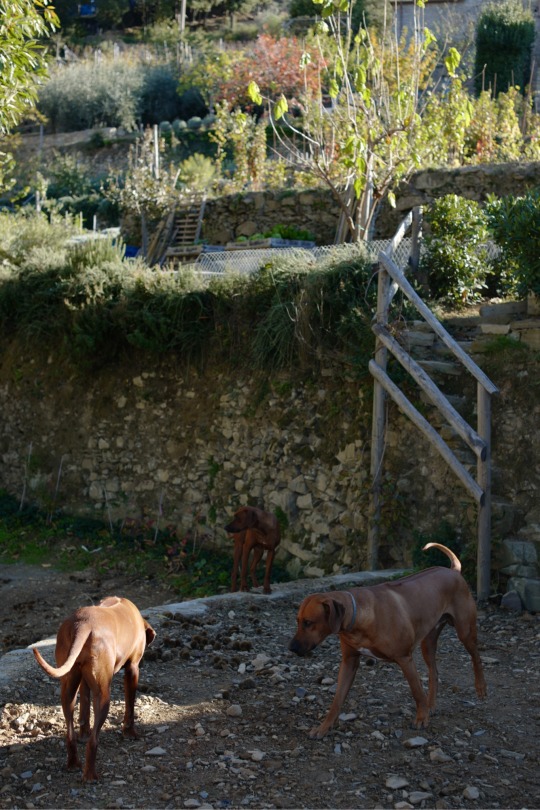

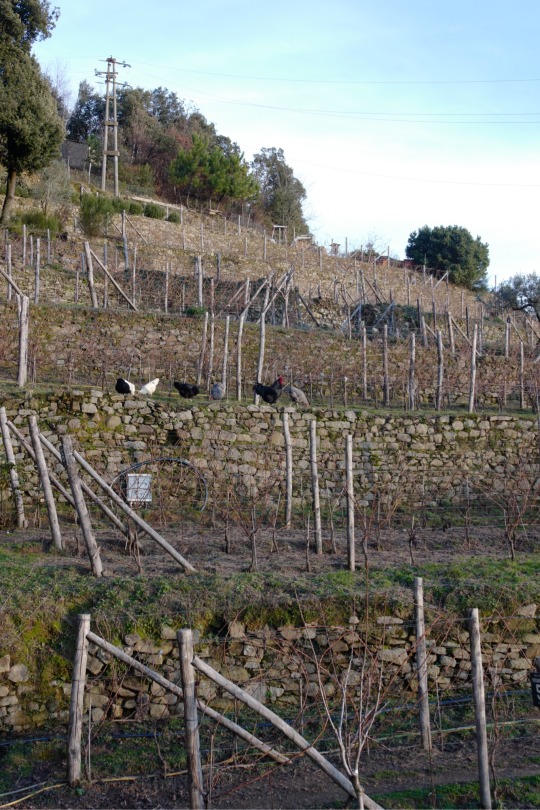
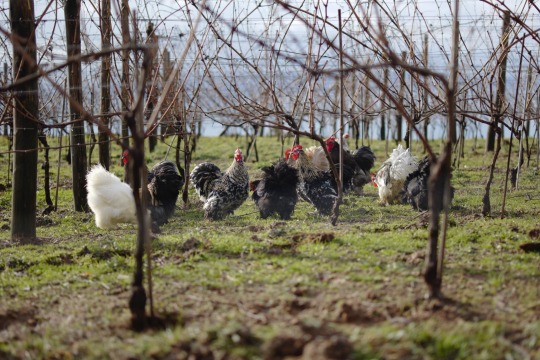
6 notes
·
View notes
Text
A heart-pounding craft
This is it: the last bunch of grapes is nabbed by the de-stemmer. Once the journey of the grapes is over, the journey of the wine begins.
This fleeting moment is the "rien ne va plus" of the wine-growing year, the work in the field, the harvest and the move to the winery: the wine's ultimate home. Ah, what a sigh of relief!
The end of a journey made of a thousand unknowns one after another, a thousand decisions to be made, day after day.
The winemaker's trade is a heart-stopping one. Harvesting is a birth that occurs, precisely, in the ninth month of pregnancy. If managed naturally, until the very last moment one does not know when it will occur.
Once filled, the boxes of grapes at Stella di Lemmen go from arm to arm and finally down the mountain: they rendezvous where the rack begins, are loaded and have a nice ride with a sea view, not without a few jolts and a few extra heart palpitations for the driver because of the weight and speed of the convoy on the steepest sections of monorail, almost as if they were on a roller coaster.
Up and down, up and down. Each journey ends with the heartening sight of the Litoranea road and the final comfort due to the slowing of the end of the ride. Saved, once again - we load the Ape and off with the transport to the cellar.
In the de-stemmer, the disappearance of the bunches follows at a rapid pace and each evening the day's grapes already rest in their tank, the cradle of the must.
The succession of seasons, weather patterns and the attention lavished on the vineyard, as well as the land that hosts it, turn to the final gathering, its florilegium: the wine.
He will express his past, the summary of the last vintage.
"In vino veritas," said the Latins. Wine does not lie, and it should help us not to lie. That is why we like it, why it intrigues us: because truth, for all of us, is vital, is sacred.
What to say? Thank you all guys, it was great once again. Thank you for your participation, your generosity, the effort, the synergy, the moment of life spent together, the tension as well as the laughter shared.
Bravo to all of us, from the oldest to the youngest. Thank you and...cheers!
I forgot: now, Konstantin, you take care of it! And the heartbreak continues...
Un mestiere al cardiopalma
Ci siamo: anche l’ultimo grappolo viene acciuffato dalla diraspatrice. Finito il viaggio dell’uva, inizia quello del vino.
Questo istante fuggente è il "rien ne va plus" dell’anno viticolo, del lavoro in campo, della vendemmia e del trasferimento in cantina: la casa del vino. Ah, che sospiro di sollievo!
La fine di un percorso fatto di mille incognite una dopo l'altra, mille decisioni da prendere, giorno dopo giorno.
Il mestiere del vignaiolo è un mestiere al cardiopalma. La vendemmia un parto che si verifica, appunto, al nono mese di gravidanza. Se gestito in modo naturale, fino all’ultimo non si sa quando avverrà.
Una volta riempite, le cassette di uva a Stella di Lemmen passano da braccia a braccia e infine scendono dalla montagna: si danno appuntamento dove inizia la cremagliera, vengono caricate e si fanno un bel viaggio con vista mare, non senza qualche scossone e qualche palpito del cuore in più per il conducente, per via del peso e della velocità del convoglio nei tratti di monorotaia più ripidi, quasi fossimo su un ottovolante.
Su e giù, su e giù. Ogni viaggio termina con la rincuorante vista della Litoranea ed il conforto finale dovuto al rallentamento del fine corsa. Salvi, ancora una volta - si carica l’Ape e via col trasporto in cantina.
Nella diraspatrice la sparizione dei grappoli si sussegue a ritmo veloce ed ogni sera le uve della giornata già riposano nella loro vasca, la culla del mosto.
Il susseguirsi delle stagioni, dell’andamento climatico e delle attenzioni elargite alla vigna, così come alla terra che la ospita, volgono all’adunata finale, il suo florilegio: il vino.
Lui ci restituirà il suo trascorso, il riassunto dell’ultima annata.
“In vino veritas” dicevano i latini. Il vino non mente, e ci dovrebbe aiutare a non mentire. Per questo ci piace, ci intriga: perché la verità, per tutti noi, è vitale, è sacra.
Che dire? Grazie a tutti ragazzi, è stato bello ancora una volta. Grazie della vostra partecipazione, della vostra generosità, della fatica, della sinergia, del momento di vita trascorso insieme, della tensione così come della risata condivise.
Bravi a tutti noi, dai più anziani ai più giovani. Grazie e...salute!
Dimenticavo: adesso, Konstantin, pensaci tu! E il cardiopalma continua...
#farm#biodynamicfarming#winery#cinqueterre#biodynamicwine#wineharvest#biodinamica#biologico#winelover
2 notes
·
View notes
Text

Summer morning
It's a blessing! Such a morning rarely happens. No one passes by on the trail, the guests are still asleep, it is Sunday, and therefore the crew didn't come to work: no motorcarts or brush cutters, no vociferating in the vineyards, all is silent at Stella di Lemmen.
All that can be heard is the song of the little birds and that of the roosters, which, freed from their night shelters, call out to each other from afar, competing to see who can sing best. They are joined by the tenuous hum of a few bumblebees on the lawn (they are the first to get to work) and the gentle rustle of olive tree branches around the house, moved by the breeze.
The sun has not yet emerged from behind the hill, and without its presence the silvery light offers a rare intimacy and heralds a glorious day. The sky screen lights up in anticipation.
The light rain two days ago has made the endless shades of green around us more intense: vines, trees, bushes - everything seems to quiver in the early morning light.
A few breaths of air sway the tops of the trees and the highest shoots of the vines: they look like arms that, raised, wave from afar. It is likely that later the wind will strengthen, but for now it is only a timid hint that gently envelops us in coolness and stillness and sends us back to breath, the foundation of our life.
The sea sheds its purple dress, that of farewell to darkness, and changes to cobalt, preparing to welcome the sun.
It appears motionless from here, but if you pay attention you can make out the succession of long waves driven by a last breath of the mistral. Soon it will become an expanse of glistening blue.
What enchantment is all this beauty, what joy, what wonder! An instant of magic that reflects our intimacy. Nature - thriving, vibrant, disarming - offers itself for what it is: an impassive, immovable, untouched mirror.
For beauty, peace, love and what some call "the kingdom of heaven" are all here, exclusively within us.
Mattina d'estate
È una benedizione una mattina così, capita di rado. Nessuno passa sul sentiero, gli ospiti dormono ancora, è domenica e di conseguenza i ragazzi non sono venuti al lavoro: niente motocariole o decespugliatori, né vociare nelle vigne, tutto tace a Stella di Lemmen.
Sì sente soltanto il canto degli uccellini e quello dei galli, che liberati dai loro ricoveri notturni si chiamano da lontano facendo la gara a chi canta meglio. Si aggiungono tenui il ronzio di qualche bombo sul prato (sono i primi a mettersi al lavoro) ed il fruscio dei rami degli ulivi intorno a casa, mossi dalla brezza.
Il sole non è ancora spuntato da dietro la montagna, e senza la sua presenza la luce argentea offre una rara intimità e annuncia una giornata gloriosa. Lo schermo del cielo si accende nell'attesa.
La leggera pioggia dell’altro ieri ha reso le infinite tonalità di verde che ci circondano più intense: vigne, alberi, cespugli, tutto sembra trepidare nella prima luce mattutina.
Qualche alito d'aria fa dondolare le cime degli alberi e i tralci più alti delle vigne: paiono braccia che, levate, salutano da lontano. È probabile che più tardi il vento si rafforzi, ma per ora è solo un timido accenno che ci avvolge delicatamente di frescura e di quiete e ci rimanda al respiro, il fondamento della nostra vita.
Il mare si spoglia del suo vestito violaceo, quello di addio alle tenebre, e si veste di cobalto preparandosi ad accogliere il sole.
Appare immobile da qui, ma se si presta attenzione si scorge il susseguirsi delle lunghe onde sospinte da un ultimo alito di maestrale. Presto diventerà una distesa di rilucente blu.
Che incanto tutta questa bellezza, che gioia, che meraviglia! Un istante di magia che riflette la nostra intimità. La natura - prospera, vivace, disarmante - si offre per quello che è: uno specchio impassibile, inamovibile, intatto.
Perché la bellezza, la pace, l'amore e quello che qualcuno chiama “il regno dei cieli” sono tutti qui, esclusivamente dentro di noi.

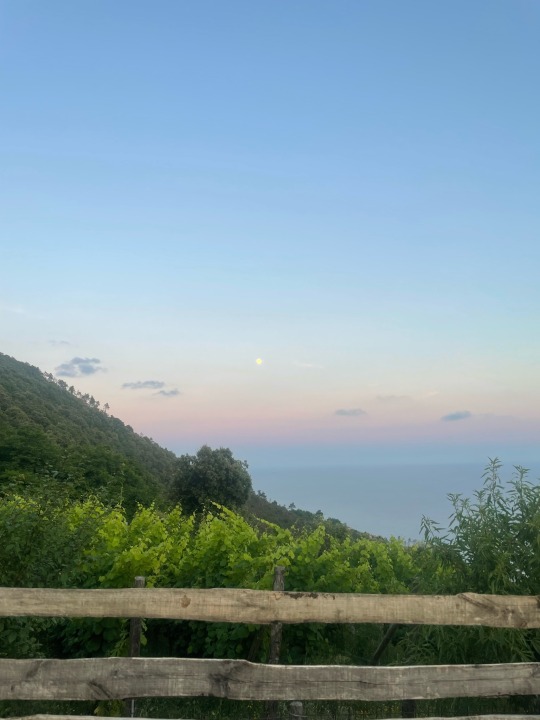
#biodynamicfarming#farm#sunrise#summer morning#biodinamica#aziendaagricolabiologica#aziendaagricolabiodinamica#nature#biodynamicwine#farming#biologico#cinqueterre#cinque terre
2 notes
·
View notes
Text

Hello lavender!
In a sea of lavender, I would like to take strokes of wonder.
(Fabrizio Caramagna)
Lavender is currently one of the undisputed stars here in Stella di Lemmen. It is in full bloom and offers its best in every sense of the word - beautiful, colorful, fragrant. It appears to us everywhere gently and discreetly, dressed in its various hues and shades: from white to pink, from lilac to purple to deep blue.
Pollinating insects adore it: bees in the lead, visiting it already early in the morning, but also bumblebees, staying until late in the evening! Those who approach a bush are immersed in a vibrant, unison buzzing...which is not at all dangerous. The insects are busy exclusively foraging and, if disturbed, simply change flower.
Lavender is a Mediterranean scrub bush that usually remains around a meter in diameter or so. On bare mountain slopes it reaches up to 1,400 meters above sea level, with smaller specimens that develop even more vivid colors.
It has about 30 species, some of them native to Italy such as Spica, Vera, Latifolia, Dentata and Stoechas. The latter, an elegant variety with showy insect wing-like bracts at the head of the flower, is the most fragrant and re-blooming of all.
All these species and many others are present on our farm, scattered everywhere and actively participating in the biodiversity and beauty of the entire agricultural organism; they are a even more exceptional presence as the plants are at ease in poor and stony soils and, once started, do not need a single drop of water except that which is bestowed by the sky!
Wherever they are found, with their hues and intense fragrance they bring joy, awe and serenity...until harvest time comes, usually in late July. We are almost there! The most suitable varieties will be stripped of their spiky inflorescences, which we will distill to extract the precious essence.
Already the ancient Egyptians employed lavender essential oil because of its antiseptic properties, while the Romans added it to bath water to perfume, but also to purify themselves and "wash" themselves of diseases - hence its name.
At Stella di Lemmen it will accompany us and comfort us throughout the winter: as a room fragrance, for a temple massage in case of headaches, in herbal teas and in the preparation of delicious Christmas cookies. It will also serve to ward off insects and protect our clothing in the closets as well as, at all times, bestow its unmistakable aroma upon us.
By transforming the light, lavender elaborates its healing, calming and relaxing power, which brings benefits in anxious states or nervous disorders, soothes the soul and conciliates sleep. Even its color says so: a true gift from heaven!
Ciao lavanda!
“In un mare di lavanda vorrei fare bracciate di meraviglia.”
(Fabrizio Caramagna)
La lavanda al momento è una delle indiscusse protagoniste qui a Stella di Lemmen. È nel pieno della fioritura ed offre il meglio di sé in tutti sensi - bella, colorata, profumata. Ci appare in ogni dove con gentilezza e discrezione, vestita delle sue diverse tinte e sfumature: dal bianco al rosa, dal lilla al viola fino al blu intenso.
Piace, - ah come piace! - agli insetti impollinatori: le api in testa, che la visitano già di prima mattina, ma anche i bombi, che rimangono fino a tarda sera! Chi si avvicina ad un cespuglio si immerge in un vibrante, unisono ronzio…per nulla pericoloso. Gli insetti sono occupati esclusivamente a bottinare e, se vengono disturbati, si limitano a cambiare fiore.
La lavanda è un cespuglio della macchia mediterranea che solitamente rimane intorno al metro di diametro o poco più. Sugli scarni declivi montani si spinge fino ai 1.400 metri di altitudine, con esemplari più piccoli che sviluppano colori ancora più vivaci.
Conta una trentina circa di specie, alcune delle quali originarie dell'Italia come la Spica, la Vera, la Latifolia, la Dentata e la Stoechas. Quest'ultima, elegante varietà dalle vistose brattee simili ad ali di insetto in capo al fiore, è la più profumata e rifiorente in assoluto.
Tutte queste specie e molte altre sono presenti nella nostra azienda, sparse in ogni dove e attivamente partecipi alla biodiversità e alla bellezza dell'intero organismo agricolo; ancor più eccezionale presenza in quanto le piante sono a loro agio anche in terreni poveri e sassosi e, una volta avviate, non necessitano di una sola goccia d'acqua se non quella elargita dal cielo!
Ovunque si trovino, con le loro tinte ed il loro profumo intenso apportano gioia, stupore e serenità...fin quando giunge l'epoca della raccolta, solitamente a fine luglio. Ci siamo quasi! Le varietà più adatte verranno private delle loro infiorescenze a spiga, che distilleremo per ricavarne la preziosa essenza.
Già gli antichi Egizi impiegavano l'olio essenziale di lavanda per via delle sue proprietà antisettiche, mentre i Romani lo aggiungevano all'acqua del bagno per profumarsi, ma anche per purificarsi e "lavarsi" dalle malattie - da qui il suo nome.
A Stella di Lemmen ci accompagnerà e conforterà durante tutto l'inverno: come aroma d'ambiente, per un massaggio alle tempie in caso di mal di testa, nelle tisane e nella preparazione di deliziosi biscotti natalizi. Servirà inoltre ad allontanare gli insetti e a proteggere i nostri indumenti negli armadi oltre che, in ogni momento, ad elargire il suo inconfondibile aroma.
Trasformando la luce, la lavanda elabora il suo potere curativo, calmante e rilassante, che arreca benefici negli stati ansiosi o nei disturbi nervosi, rasserena l’animo e concilia il sonno. Lo dice anche il suo colore: un vero dono del cielo!
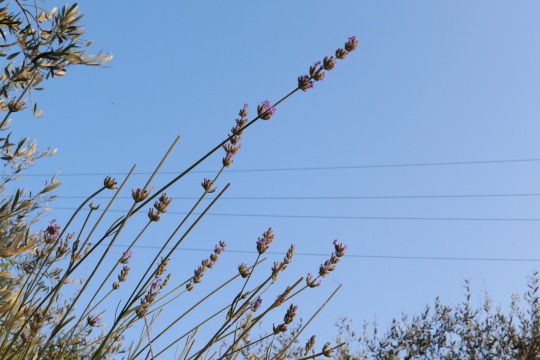
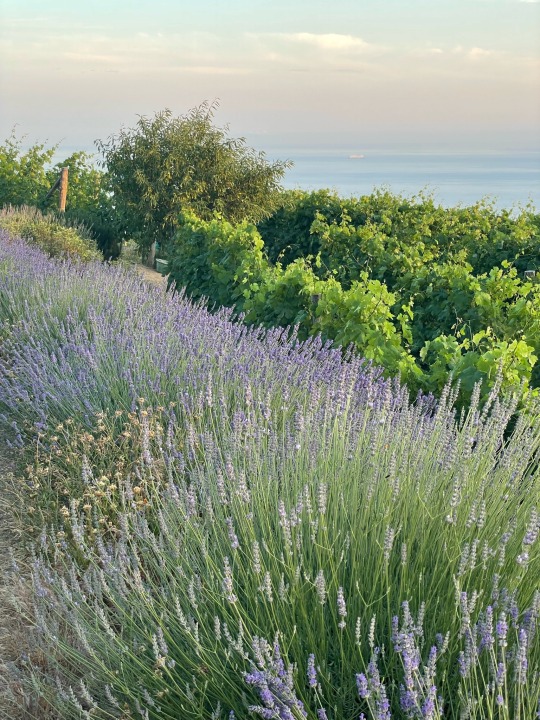
#farm#biodynamicfarming#biologico#nature#lavanda#lavender#aziendaagricolabiodinamica#aziendaagricolabiologica#biodiversity#biodinamica#organicfarming
3 notes
·
View notes
Text


The path of doing
We are approaching the summer solstice, which in our hemisphere represents the longest day of the year. It is the event that marks the beginning of summer, in which the celestial star reaches its zenith and its rays strike our hemisphere perpendicularly. Since ancient times, this moment of welcoming the sun and the ultimate power of nature has been celebrated.
Walking through Lemmen's vineyards, vegetable gardens and orchards, one can clearly sense the apotheosis of the fertility and bounty of the earth and the ripeness and fullness of the plant world.
Flowers are everywhere, and with them come myriads of insects, including bees, bumblebees, wasps and butterflies, foraging for nectar or pollen. Vegetables and fruits take on color amid the endless shades of green given off by the grasses and leaves reaching their brightest and deepest hues.
As we tread the paths immersed in such beauty and diffused with graceful scents, our thoughts return to our own path: an endless apprenticeship and a close and continuous dialogue with the elements of nature.
As the daily toil and difficulties pale in the sunlight, what emerges instead is the gift of having to engage, day after day, in this inexhaustible confrontation.
The period coming to a close has been filled with challenges, one among them the great drought of last year. We like to think that it comes to an end now, with the summer solstice, at the height of brightness and fullness, and that from here it is heading with new strength and clarity toward the next harvest and the beginning of the tenth year of Stella di Lemmen.
Living and learning in nature is an honor and a privilege. Walking the paths of Lemmen is a plunge into the depths of life. Try it to believe: you are all invited.
Il percorso del fare
Ci avviciniamo al solstizio d’estate: il giorno più lungo dell'anno, in cui la luce del sole sconfigge definitivamente le tenebre. È l'evento che sancisce l'inizio dell'estate, nel quale l'astro celeste raggiunge lo zenit ed i suoi raggi colpiscono il nostro emisfero in modo perpendicolare. Fin dall'antichità si è celebrato questo momento di benvenuto al sole e di massimo potere della natura.
Camminando tra i vigneti, gli orti e i giardini di Lemmen si percepisce chiaramente l'apoteosi di fertilità e generosità della terra e di maturazione e pienezza del mondo vegetale.
Fiori ovunque e miriadi di insetti, tra api, bombi, vespe e farfalle, che ne bottinano il nettare o il polline. Ortaggi e frutti che prendono colore tra le infinite sfumature di verde sprigionate delle erbe e dalle foglie che raggiungono le loro tonalità più brillanti e profonde.
Calcando i sentieri immersi in cotanta bellezza e diffusi di leggiadri profumi, il pensiero torna al nostro percorso: un apprendistato infinito e un dialogo serrato e continuo con gli elementi della natura.
E allora la fatica e le difficoltà quotidiane impallidiscono sotto la luce del sole e quello che emerge è invece il dono di doversi cimentare, giorno dopo giorno, in questo inesauribile confronto.
Il periodo che si va a chiudere è stato colmo di sfide, una tra tutte la grande siccità dell'anno scorso. Ci piace pensare che giunga al termine adesso, con il solstizio d'estate, nel culmine della luminosità e della pienezza e che da qui si avvii con nuove forza e chiarezza verso la prossima vendemmia e verso l’inizio del decimo anno di Stella di Lemmen.
Vivere e apprendere nella natura è un onore e un privilegio. Camminare sui sentieri di Lemmen è un tuffo nelle profondità della vita. Provare per credere: siete tutti invitati.
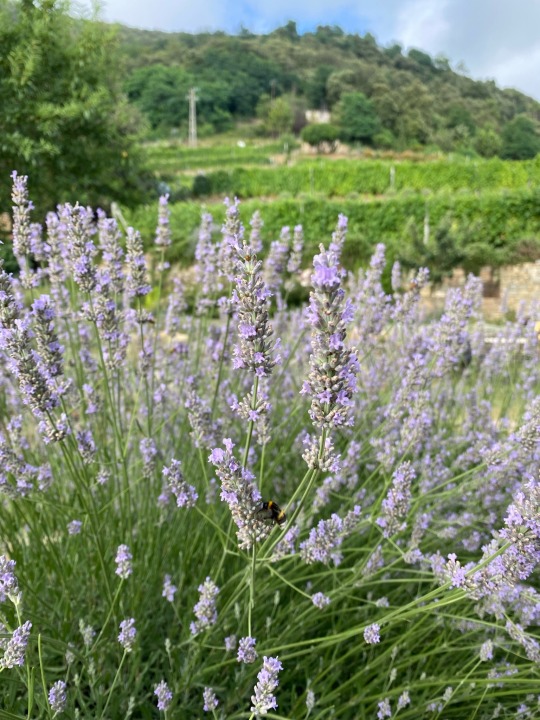
0 notes
Text
Sciacchetrà
In the vineyard we selected the most suitable bunches, those with the most sparse berries, of the Bosco, above all, and Vermentino varieties, which will create our #Sciacchetrà. 🥂
To choose the harvest period we were very careful about the acidity of the grapes, which will balance their increasing sweetness during dehydration. 🍇
We then spread the clusters on the trellises, this year also hanging them from chains.
We let the wind and sun work on the grapes for almost two months. In addition to the dehydration process, endogenous enzymatic processes in the grapes themselves contributed to their complexity. 🌞 💨
On the first days of November, the grapes were taken off the trellises and de-stemmed by hand. 🖐
#sciacchetra#italianwine#farm#wine#biodynamicfarming#biodynamicwine#biologico#farming#biodinamica#cinqueterre#grapes#organic#stelladilemmen#biodynamic#byodinamic#farmer#aziendaagricolabiologica#italy#organicfarm#travel
2 notes
·
View notes
Text
End of the year
Another year has come to an end, and it is time for evaluations. I wander around the countryside in this particularly dark and dank early winter day, before my eyes the heavy rain-soaked ground, the banked mist resting gently on the terraces, the trees and shrubs adorned with pearls of water. Only the temperature does not conform to the time of year, but who expects "normal" weather nowadays?
What appears when the light veil of "caligo" dissipates - as the fog that rises from the sea was called by the Latins - seems like a dream: no longer the barren terraces cleared of scrub and brambles of years past, but a varied and orderly vegetation that feels at ease where it has been placed and enjoys the moisture it has lacked in the interminable summer and fall.
The trunks of the fruit trees are now clearly visible, even if bare; the young olive trees already emanate their quiet tranquility and proudly show their new shoots full of life, with their light green leaflets; the rose bushes with their long falling branches, some of them even still blooming.
This silent order seems like a miracle, like it had always been this way instead of the result of persistent care and attention.
The grayness mutes the tones of the landscape, but it does not dampen the vitality that emanates from it, quite the contrary!
In the dimness, everything seems to want to show more than ever the potential lushness, the regeneration, the promise of life that resides in every branch, every leaf or blade of grass.
What better elixir of life? What more honest reward for the effort put into this undertaking?
Having passed the threshold of six decades, it becomes clear to me as never before how much the "reward" is not so much in the result as in the step by step process. Once again, I thank nature for constantly reminding me: even in the darkest hour, the light shines.
Best wishes for the New Year from all of us at Stella of Lemmen!
Fine dell'anno
Un altro anno è giunto al termine, è tempo di consuntivi. Mi aggiro per la campagna in questo inizio inverno particolarmente buio e uggioso: il terreno pesante impregnato di pioggia, la bruma a banchi che si appoggia delicatamente sulle terrazze, gli alberi e gli arbusti adorni di perle d'acqua. Soltanto la temperatura non è conforme al periodo dell’anno, ma chi si aspetta un clima "normale" ormai?
Quello che appare quando il leggero velo di "caligo" si dilegua - così veniva chiamata la nebbia che s'alza dal mare dai latini - sembra un sogno: non più le brulle terrazze ripulite da macchia e roveti degli anni passati, ma una vegetazione varia e ordinata che si sente a suo agio lì dove è stata posta e si gode l'umidità che le è mancata nell’interminabile periodo estivo e autunnale.
Scorgo i tronchi degli alberi da frutto sono ormai ben visibili, seppur spogli; i giovani ulivi già emanano la loro pacata tranquillità e mostrano orgogliosi e pieni di vita i nuovi germogli con le foglioline verde chiaro; i cespugli di rose con i lunghi rami a cadere, alcuni dei quali addirittura ancora fioriti.
Sembra un miracolo questo ordine silenzioso, sembra essere sempre stato così, non il risultato di persistenti cure e attenzioni.
Il grigiore smorza i toni del paesaggio, ma non attutisce la vitalità che da esso sprigiona, anzi!
Nella penombra, tutto sembra voler mostrare più che mai il potenziale rigoglio, la rigenerazione, la promessa di vita che custodisce ogni ramo, ogni foglia o filo d'erba.
Quale miglior elisir di vita? Quale più onesto compenso all'impegno posto nell’affrontare l'impresa?
Superata la soglia dei sei decenni, mi appare chiaro come non mai quanto la "ricompensa" non sia tanto nel risultato quanto, passo dopo, nel processo. Una volta ancora ringrazio la natura per avermelo costantemente ribadito: anche nel momento più buio risplende la luce.
Un caro augurio per il Nuovo Anno da noi tutti di Stella di Lemmen!




#farm#wine#biodynamicfarming#biodynamicwine#biologico#farming#biodinamica#cinqueterre#grapes#organic#stelladilemmen#byodinamic#biodynamic#aziendaagricolabiologica#farmer#italy#new year#2023
1 note
·
View note
Text


Reaping the rewards
Another vintage has been archived. In our cellar that still smells like new, with the gleaming steels, the pipes along the walls, all the switches and the little lights on the panel as shiny as sparkling candy, the must rests and transforms into wine in its different containers: the vats, the amphorae and a lonely barrique.
It is a unique and somewhat strange thrill to witness the processing of the grapes, if you experience it for the first time...but also if repeated from year to year, as it is always new. And then the waiting: waiting to see what comes out of a year's work in the vineyard, the meticulous selection and harvesting done between the rows, and the winemaking process that, if successful, carries with it the "spirit of the matter."
Now, walking between the rows, we see the vines still covered with green leaves that will soon yellow, but stripped of their berries: we have harvested them. A feeling of relief mixed with a vague, distant sense of emptiness is among us - the end of a cycle has come again this year.
We do not ask the plants for permission to draw the harvest, and it hardly occurs to us that it is the outcome of a transformation: the flower and then the fruit are the consequence of a process that has come to fruition.
This transformation also takes place within us; the result, the fruit, in our case is called wisdom: having "tasted life."
We humans are also called, for our own and others' sake, to express the inexhaustible richness of our inner essence through fruits that are as ripe, as sweet as possible. In this regard, we propose a toast...in the spirit of wine! Cheers!
Raccogliere i frutti
Un'altra vendemmia è stata archiviata. Nella nostra cantina che sa ancora di nuovo, con gli acciai splendenti, i tubi lungo i muri, tutti gli interruttori e le lucine dei quadri lucidi lucidi come scintillanti caramelle, il mosto riposa e si trasforma in vino nei suoi diversi contenitori: i tini, le anfore e una barrique sola soletta.
Un'emozione unica e un po' strana assistere alla lavorazione delle uve, se la si prova per la prima volta...ma anche se ripetuta di anno in anno, in quanto sempre nuova. E poi l'attesa: aspettare per vedere cosa viene fuori da un anno di lavoro in vigna, dalla selezione e dalla raccolta meticolosa effettuate tra i filari e dal processo di vinificazione che, se va a buon fine, reca con sé lo "spirito del discorso".
Adesso, camminando tra i filari, vediamo sfilare le vigne ancora coperte di verdi pampini che presto ingialliranno, ma spogliate delle loro bacche: le abbiamo vendemmiate. Una sensazione di sollievo mista ad un vago, lontano senso di vuoto si affaccia al nostro sentire. Anche quest'anno è giunta la fine di un ciclo.
Non chiediamo permesso alle piante per trarre il raccolto e difficilmente ci sovviene che esso è l’esito di una trasformazione: il fiore e poi il frutto sono la conseguenza di un processo giunto a buon fine.
Questa trasformazione avviene anche dentro di noi, il risultato, il frutto, nel nostro caso si chiama saggezza: l'aver "assaggiato la vita".
Anche noi umani siamo chiamati, per il nostro e l'altrui bene, ad esprimere l'inesauribile ricchezza della nostra intima essenza attraverso dei frutti che siano il più maturi, il più dolci possibile. A questo proposito proponiamo un brindisi...con lo spirito del vino! Salute!




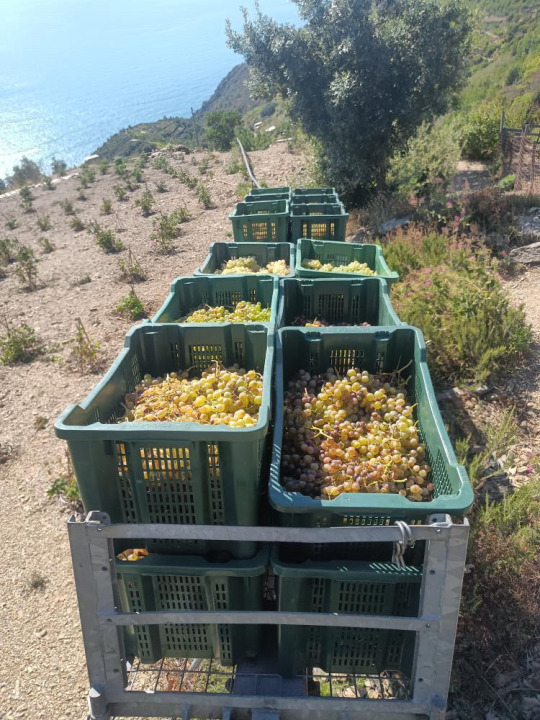


5 notes
·
View notes
Text

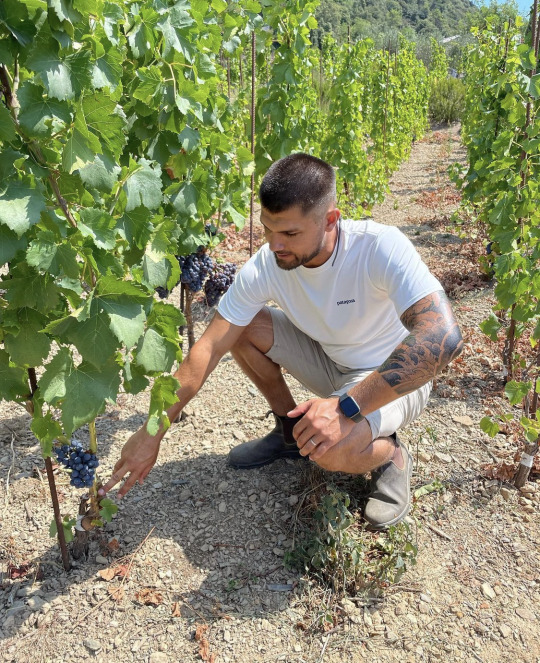
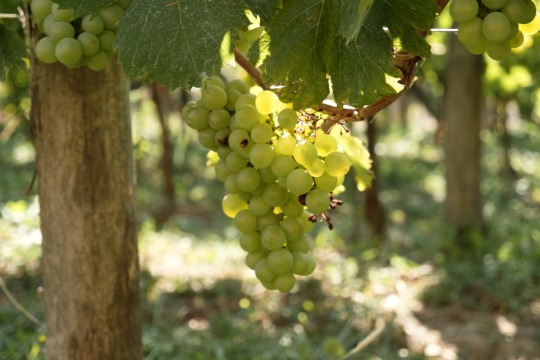
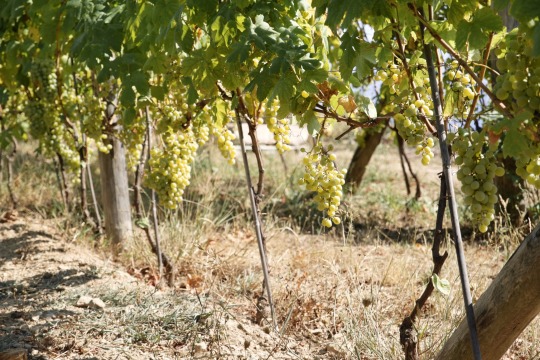
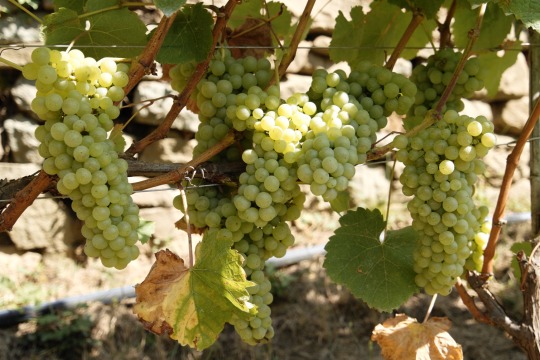
A summer on fire
Summer is ending with record temperatures across the Northern Hemisphere. But how has this affected agriculture, the grapevine in particular, and what can we expect from the 2022 harvest?
What is coming to an end has been a period of great drought and heat here in Stella di Lemmen as well. It has challenged the course of the seasons, the land and us workers. This is also why we have not been able to update our „logbook“ regularly in recent times.
The first three months of the year went by without any precipitation - we started watering in January/February! - and were interrupted only by a few scant rains in April. This led to a spring that exploded and petered out in record time, as the early warm weather soon evaporated the little moisture in the soil and plants flowered and wilted within a few weeks. One example for all: lavender, which usually blooms from early July to mid-August, had already withered by the end of June.
Trees and flora ran for cover, trying to go to seed in a great hurry to ensure reproduction before the eventual passing due to heat and drought.
Fire temperatures and no water, just a single thunderstorm from May to mid-August! All the plants suffered from the pressing heat and many, even some rosemaries, did not make it. The fatigue of the plant world was so obvious that we could not shield ourselves to be shaken by it as well.
The animals faced the heatwave by resting interminable hours motionless, seeking shade from late morning until evening.
Fortunately, in the period up to the solstice the temperature range helped, bestowing coolness and a little moisture in the night and early morning hours.
As the only exception, the vineyard coped fairly well with the sunny summer and drought, evidently benefiting from the cultivation techniques we employ and despite the fact that not a drop of irrigation was lavished on it. The ripening of the grapes developed quite evenly, slightly better in the areas where - paradoxically - the plants had less vigor. The result is a copious harvest that will soon, exceptionally soon, have to be collected and turned into wine.
The abundance of grapes will allow us, for the first time, to select the best bunches for our „Limen“, the Cinque Terre white, and to tackle some new experiments, with amphorae and barriques, aimed at growth and the pursuit of excellence.
The red grapes, of the Grenache and Canaiolo varieties, will also be a first: the first harvest! We are really excited and, as per our nature, a tiny bit anxious… :)
Now that two copious thunderstorms have returned to wet the land, and nature as a whole has been able to take a breather, we hope for a harmonious resumption of rainfall and a consequent, gradual return to normality. Plants, animals and we farmers will hopefully be able to breathe a sigh of relief.
Let's see if nature, generous as always, as a result of this difficult period will reward us with some wonderful surprises. After all... „in vino veritas“, „in wine lies the truth“!
Un’estate di fuoco
L'estate si sta concludendo con temperature record in tutto l'emisfero boreale. Ma come questo ha inciso sull’agricoltura? Che conseguenze ha sulla vite e cosa ci si può aspettare dalla vendemmia 2022?
Quello che giunge al termine è stato un periodo di grande siccità e caldo anche qui a Stella di Lemmen. Ha messo a dura prova il corso delle stagioni, la terra e noi lavoratori. Anche per questo negli ultimi tempi non ci è stato possibile aggiornare con regolarità il nostro „giornale di bordo“.
I primi tre mesi dell’anno senza precipitazioni - abbiamo iniziato ad annaffiare a gennaio/febbraio! - sono stai interrotti solo da qualche scarsa pioggia ad aprile e hanno portato ad una primavera esplosa ed esauritasi a tempo di record, perché i primi caldi hanno presto fatto evaporare la poca umidità presente nel terreno e le piante sono fiorite ed appassite nel giro di poche settimane. Un esempio per tutte: la lavanda, che di solito fiorisce dai primi di luglio a metà agosto, a fine giugno era già sfiorita.
Gli alberi e la flora sono corsi ai ripari, cercando di andare a seme in grande fretta, per garantire la riproduzione prima dell’eventuale trapasso a causa del calore e della siccità.
Temperature di fuoco e niente acqua, un unico temporale da maggio a metà agosto! Tutte le piante hanno sofferto la pressante calura e in tante, addirittura alcuni rosmarini, non ce l’hanno fatta. Troppo evidente la fatica del mondo vegetale per non rimanerne scossi anche noi.
Gli animali hanno affrontato la canicola riposando interminabili ore immobili, ricercando l’ombra dalla tarda mattinata fino a sera.
Per fortuna, nel periodo fino al solstizio l’escursione termica ha aiutato, elargendo frescura e un poco di umidità nelle ore notturne e di primo mattino.
Come unica eccezione, il vigneto ha retto egregiamente all’estate assolata e alla siccità, beneficiando evidentemente delle tecniche colturali che utilizziamo e nonostante non una goccia di irrigazione gli sia stata elargita. La maturazione delle uve si è sviluppata in maniera omogenea, leggermente migliore nelle zone dove – paradossalmente – le piante presentavano meno vigoria. Il risultato è un raccolto copioso che a breve, eccezionalmente presto, dovrà essere vendemmiato e trasformato in vino.
L’abbondanza di uva ci consentirà per la prima volta di selezionare i grappoli migliori per il nostro „Limen“, il bianco delle Cinque Terre, e di affrontare qualche nuovo esperimento, con anfore e barrique, mirato alla crescita e alla ricerca dell’eccellenza.
Anche il rosso, varietà Grenache e Canaiolo, sarà una novità assoluta: il primo raccolto! Siamo davvero entusiasti e, come da nostra natura, un briciolo ansiosi…
Ora che due copiosi temporali sono tornati a bagnare la terra e la natura tutta ha potuto prendere respiro, si spera in un'armonica ripresa delle precipitazioni ed un conseguente, graduale, ritorno alla normalità. Le piante, gli animali e noi contadini potremo auspicabilmente tirare un sospiro di sollievo. Chissà se la natura, generosa come sempre, come risultato di questo difficile periodo ci premierà con qualche meravigliosa sorpresa. In fondo...“in vino veritas“!
1 note
·
View note
Photo


There are three ways
There are three ways to reach Stella di Lemmen, always and exclusively on foot: ascending from the path that starts from the coastal road, descending from the Telegrafo or, in the opposite direction, taking the path that leads from the Sanctuary of the Madonna di Montenero to the Telegrafo (and then on to Portovenere).
The latter option, which intersects the farm about halfway through, on a flat section of the path, is certainly the most striking.
The view from the plateau of the Sanctuary, at the start, is breathtaking: the sea with a wide stretch of coastline both east and west seems to loom up to embrace us, while the shade of the pines around the building provides friendly shelter.
Continuing along the trail, after a sharp right turn slightly uphill, the path becomes flat again and shortly afterwards we can see below the "Costa de Sera" with its fields sloping down to the sea.
Once we reach the beautiful vineyard of "Travandasca," tended by its owners Mario and Luciano, the view of Stella di Lemmen opens up in the distance, and from there on appears and disappears multiple times, interrupted by heather, patches of broom or tall trees such as turkey oaks and chestnuts.
As we approach the farm step by step, the view overlooks the terraces, vineyards, vegetable gardens, and trees, and a feeling of peace and harmony, of great tranquility presents itself to our hearts.
When finally the whole view opens to Stella di Lemmen, it is impossible not to feel a vague astonishment, like when the magician pulls the white rabbit out of the hat: "but...what's going on?!"
The farm, still a work in progress, is the largest in the Cinque Terre in terms of cohesive land area, and is the only biodynamic agricultural organism in the region.
It is now eight years that we have been taking care of this place and that this place has been taking care of us, a challenging and increasingly intense "dialogue" that goes on day after day. A continuous confrontation with the earth, with plants and animals, with weather events, the sky, the moon...and the stars.
As far as we can, we try more than anything else to "listen," because in our opinion it is the right key, the only plausible one to act in harmony with nature and to be able to keep the spirit of the place unchanged - or more, well alive.
The Cinque Terre are in their entirety a magical place, vibrant with energy and uniquely beautiful. Set in this context, Stella di Lemmen can really shine, enriched by the potential of the virtuous circle that is triggered when we humans respect what is beautiful, precious and true around us.
Ci sono tre modi
Ci sono tre modi per raggiungere Stella di Lemmen, sempre e solamente a piedi: salendo dal sentiero che parte dalla strada litoranea, scendendo dal sentiero del Telegrafo oppure, in direzione opposta, imboccando il sentiero che dal Santuario della Madonna di Montenero porta al Telegrafo (e prosegue poi per Portovenere).
Quest’ultima opzione, che interseca circa a mezza altezza l’azienda con un tratto di cammino pianeggiante, è certamente la più suggestiva.
Il panorama dal pianoro del Santuario, alla partenza, è mozzafiato: il mare con un ampio tratto di costa sia a est che a ovest sembra incombere fino a volerci abbracciare, mentre l’ombra dei pini intorno alla costruzione fornisce un’amichevole riparo.
Continuando il percorso, dopo una decisa svolta a destra in leggera salita, il sentiero torna pianeggiante e poco dopo si può ammirare in basso la “Costa de Sera” con i suoi campi che scendono fino al mare.
Una volta raggiunto il bel vigneto di “Travandasca”, curato dai suoi proprietari Mario e Luciano, ecco aprirsi in lontananza la visuale su Stella di Lemmen che da lì in poi appare e scompare interrotta a tratti dalle eriche, da macchie di ginestre, o da piante ad alto fusto come cerri e castagni.
Mentre ci avviciniamo, passo dopo passo, la vista si affaccia sui terrazzamenti, sui vigneti, gli orti, i giardini e gli alberi, ed una sensazione di pace e armonia, di grande tranquillità si presenta al nostro cuore.
Quando infine l’intera visuale si apre su Stella di Lemmen, è impossibile non provare un vago stupore, come quando il prestigiatore tira fuori il coniglio bianco dal cappello: “Ma...che cosa succede?!”
L’azienda, ancora in divenire, è la più grande delle Cinque Terre per estensione di terreni accorpati e rappresenta l'unico organismo agricolo biodinamico della zona.
Sono ormai otto anni che ci prendiamo cura di questo luogo e che questo luogo si prende cura di noi, un “dialogo” impegnativo e sempre più intenso che va avanti giorno dopo giorno. Un confronto continuo con la terra, con le piante e con gli animali, con gli eventi atmosferici, il cielo, la luna...e le stelle.
Per quanto ci è possibile cerchiamo più che altro di “ascoltare”, perché questa secondo noi è la chiave giusta, l’unica plausibile per agire in armonia con la natura e poter mantenere inalterato – o di più, ben vivo – lo spirito del posto.
Le Cinque Terre sono nella loro interezza un luogo magico e vibrante di energia, di una bellezza unica al mondo. Stella di Lemmen splende incastonata in questo contesto, arricchita dal potenziale del circolo virtuoso che si innesca quando noi umani rispettiamo quanto c’è di bello, di prezioso e di vero intorno a noi.
#stelladilemmen#cinqueterre#Italy#trekking#camminando#cammino#aziendaagricolabiologica#aziendaagricolabiodinamica#biodinamica#biologico#agricolturabio#biodynamic#biodynamicwine#biodynamicfarming#organic#organicfarm#farm
1 note
·
View note
Text

Eggs and Easter
Egg production from our hens is at an all-time high. Every day, twenty to thirty exquisite eggs are at our disposal and are punctually distributed among us or to friends and collaborators passing by.
It's hard to find tastier eggs: Stella di Lemmen's hens, which during the night are closed in several small hen houses distributed around the farm, in order to protect them from predators, during the day are free to roam in the vineyards and fields, in the woods and in the olive groves...and alas sometimes even in the vegetable gardens, where they really shouldn't!
Each family, headed by a rooster, is scattered throughout the territory without interfering or engaging in disputes with the others. Similarly, the different breeds - dwarf or regular - do not mix with each other but form well-assorted and homogeneous groups.
The high quality of the eggs is closely related to the variety of the diet: the chickens can eat, as they like, the organic feed we give them, but also grass and various seasonal vegetables and, above all, insects and larvae, of which they are greedy and which characterize their omnivorous, not vegetarian, diet.
The fact that chickens roam the fields is also healthy for the vineyard and other vegetation, because they raid insects that can damage crops. An example among many is the "Noctua fimbriata", a moth that deposits its eggs in the crevices of the bark of the vine and whose larvae, in spring, feed on the new buds, destroying the vegetation and ultimately causing the death of the plant.
Our eggs have different colors and sizes depending on the size of the breed: white, red, pink, even blue or green if they are from "Araucana" hens or chocolate colored if they are from "Marans".
Of course, hens lay eggs to ensure the continuity of specialization and not our production of excellent omelets...for this reason springtime is all a fervor of hens brooding, sometimes disappearing to build nests in secluded places, then reappearing suddenly with the chicks in tow.
The egg is a symbol of new life and rebirth. Since the Middle Ages, people in Germany used to give boiled eggs (wrapped in leaves and flowers so that they would dye naturally) as a good omen for Easter. To celebrate Spring, the Persians gave eggs as a wish for a new beginning, while for the ancient Egyptians the egg was the origin of everything and the fulcrum of the four elements (air, water, earth and fire) - in short: of life!
The Christian tradition associates the egg with the resurrection of Christ, and later in time, the sweetness of the chocolate eggs that were given as gifts to cheer Easter (they say by a Turin pastry chef) was completed by the addition of a small surprise inside.
Even for us the birth of a chick, from that unfathomably intact and perfect casket, is always a surprise, a promise of life that comes true.
Let us celebrate this promise together! Let us reflect on the importance of life, on its uniqueness and sacredness, on the fact that it is our task and duty to preserve and protect it rather than hinder and destroy it.
Honoring life and our humanity is a duty, because we really need it, because we urgently need it.
Happy Easter from Stella di Lemmen!
Uova e Pasqua
La produzione di uova delle nostre galline è al massimo. Ogni giorno venti/trenta uova squisite sono a nostra disposizione e vengono puntualmente distribuite tra di noi o ad amici e collaboratori di passaggio.
Difficilmente si possono trovare uova migliori: le galline di Stella di Lemmen, che di notte vengono chiuse in diversi piccoli pollai distribuiti nell'azienda in modo da proteggerle dai predatori, di giorno sono libere di razzolare nelle vigne e nei campi, nel bosco e nell'uliveto...e ahinoi a volte anche negli orti, dove non devono!
Ogni famiglia, con a capo un gallo, si distribuisce sul territorio senza interferire o ingaggiare dispute con le altre. Allo stesso modo le diverse razze - nane o regolari - non si mischiano tra di loro ma formano dei gruppetti ben assortiti ed omogenei.
L'alta qualità delle uova è strettamente correlata alla varietà dell'alimentazione: i polli possono mangiare a loro gradimento il mangime biologico che gli viene da noi elargito, erba e vegetali vari di stagione e soprattutto insetti e larve, dei quali sono ghiotti, che contraddistinguono la loro alimentazione onnivora, non vegetariana.
Che le galline scorrazzino per i campi è salutare anche per la vigna e le altre vegetazioni, perché fanno razzia di insetti che possono danneggiare le coltivazioni. Un esempio tra tanti è la "Noctua fimbriata" , una falena che deposita le uova negli anfratti della corteccia della vite e le cui larve, a primavera, si cibano delle nuove gemme distruggendo la vegetazione fino a causare la morte della pianta.
Le nostre uova hanno diversi colori e formati a seconda della grandezza della razza: bianche, rosse, rosa, addirittura azzurre o verdi se si tratta di galline "Araucana" o color cioccolato se sono "Marans".
Certo, le galline depongono le uova per assicurare la continuità della specializzazione e non la nostra produzione di ottime frittate...per questo a primavera è tutto un fervore di chiocce che covano, a volte scomparendo per costruirsi nidi in luoghi appartati ed introvabili, ricomparendo poi, all’improvviso, con i pulcini al seguito.
L'uovo è un simbolo di nuova vita e di rinascita. Fin dal medioevo, in Germania si usava regalare uova bollite avvolte in foglie e fiori in modo che si tingessero naturalmente, come buon auspicio per Pasqua. Per celebrare la Primavera, i Persiani regalavano uova come augurio per un nuovo inizio, mentre per gli antichi Egizi l'uovo era l'origine di tutto e il fulcro dei quattro elementi (aria, acqua, terra e fuoco) - in poche parole: della vita!
La tradizione Cristiana associa l'uovo alla resurrezione del Cristo e più avanti nel tempo, alla dolcezza delle uova di cioccolata che si regalavano per allietare la Pasqua (dicono ad opera di un pasticcere torinese) viene aggiunta all’interno una piccola sorpresa.
Anche per noi la nascita di un pulcino, da quell'insondabile scrigno integro e perfetto, è sempre una sorpresa, una promessa di vita che si avvera.
Celebriamo insieme volta questa promessa! Riflettiamo sull'importanza della vita, sulla sua unicità e sacralità, sul fatto che è nostro compito e dovere preservarla e proteggerla piuttosto che ostacolarla e distruggerla.
Onorare la vita e la nostra umanità è un dovere, perché ne abbiamo davvero bisogno, perché ne abbiamo urgenza.
Buona Pasqua da Stella di Lemmen
2 notes
·
View notes
Text
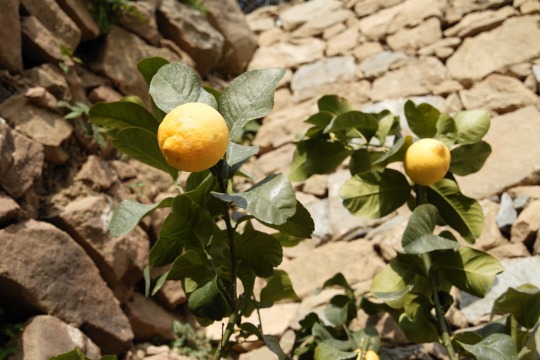
Shopping for citrus
Sometimes the urge to go shopping becomes irresistible and leads us to wander around town looking for clothes, shoes or bags....
Even at Stella di Lemmen we are not immune to the shopping fever, but instead of clothing, from time to time we have to satisfy our need for...plants!
When that's the case, we take the van and head to the Pistoia, Tuscany area, famous for its countless plant nurseries. This time we were in need of citrus plants, to be put along the walls of the olive grove. So we went to the fantastic nursery of the Lenzi family @agrumilenzi, where you can find an endless choice of the most aromatic, curious and multicolored varieties of citrus. This family of plants is characterized by a great ease of crossing: all the varieties we know are combinations and recombinations of the three "ancestor" varieties, mandarin, citron and pomelo. In addition to the best known fruits, such as oranges, lemons and grapefruit, over the centuries chinotto, kumquat, yuzu, bergamot, finger lime and so on were created. And we, on our shopping tour, bought some of each one of them!
These days the young trees are being planted, interspersed among the olive trees. In a few years, the juicy fruits and fragrant peels full of essential oils will be the base of lemonades, jams, syrups, hydrolates and much more.
A spesa di agrumi
A volte la voglia di shopping diventa irresistibile e ci porta a girare per la città alla ricerca di vestiti, scarpe o borse...
Anche a Stella di Lemmen non siamo immuni dalla febbre dello shopping, ma al posto dell'abbigliamento di tanto in tanto dobbiamo soddisfare il nostro bisogno di...piante!
Quando è così, prendiamo il furgone e ci muoviamo verso la zona di Pistoia, in Toscana, famosa per i suoi innumerevoli vivai. Questa volta necessitavamo di piante di agrumi, da mettere a spalliera lungo i muri dell'uliveto. Siamo quindi andati al fantastico vivaio della famiglia Lenzi @agrumilenzi, dove si può trovare una scelta infinita delle più aromatiche, curiose e multicolori varietà di agrumi. Questa famiglia di piante è caratterizzata da una grande facilità di incrocio: tutte le varietà che conosciamo sono combinazioni e recombinazioni delle tre varietà "antenate", mandarino, cedro e pomelo. Oltre ai frutti più conosciuti, come arance, limoni e grapefruit, nel corso dei secoli sono stati creati chinotti, kumquat, yuzu, bergamotti, finger lime e così via. E noi, nel nostro shopping tour, ne abbiamo comprati di tutti un po'!
In questi giorni gli alberelli vengono messi a dimora, intercalati tra gli ulivi. Tra qualche anno, i frutti succoso e le odorose bucce piene di oli essenziali saranno la base di limonate, marmellate, sciroppi, idrolati e molto altro.


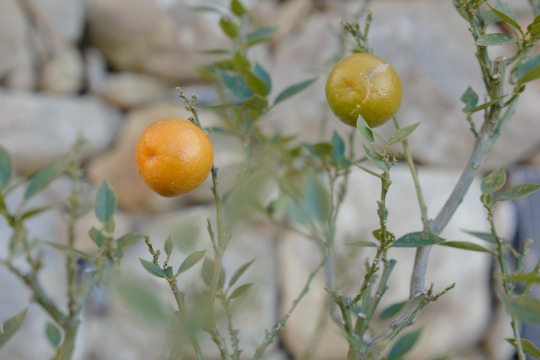
3 notes
·
View notes